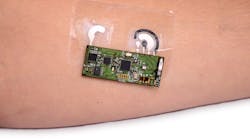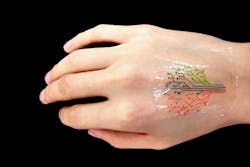Engineers at the Massachusetts Institute of Technology have devised a 3D printing technique that uses ink made from living cells engineered to light up in response to a variety of stimuli. When mixed with a slurry of hydrogel and nutrients, the cells can be printed layer by layer to form three-dimensional, interactive structures and devices.
The researchers say their technique can be used to fabricate “active” materials for wearable sensors and interactive displays. These materials can contain live cells engineered to sense specific stimuli and light up in response to environmental chemicals and pollutants, as well as changes in pH and temperature.
Previous efforts to do this with mammalian cells failed, with the cells dying during the printing process. That’s because mammalian cells are basically lipid bilayer balloons and are too weak, so they rupture easily.
So the MIT team took another tack: using stronger bacteria cells. It soon discovered bacterial cells have tough walls that survive relatively harsh conditions, such as the forces applied to ink as it gets pushed through a printer’s nozzle. Furthermore, bacteria—unlike mammalian cells—are compatible with most hydrogels (gel-like materials made from mostly water and a bit of polymer). The group found that hydrogels provide an aqueous environment that supports living bacteria. And after extensive research, it found a hydrogel with pluronic acid to be the most compatible. The hydrogel also exhibited an ideal consistency for 3D printing.
A vaguely tree-shaped patch was 3D printed out of an ink containing bacteria cells genetically programmed to light up in the presence of certain chemical or compounds. When placed on a person’s hand that was partially coated with the chemical, that portion of the tree lit up.
The researchers then came up with a recipe for their 3D ink using a combination of bacteria, hydrogel, and nutrients to sustain the cells. They found the ink worked well and print at a resolution of about 30 micrometers per feature. That means each printed line contains only a few cells, but they can also print relatively large-scale structures, measuring several centimeters.
The team used a custom 3D printer it had built using standard elements combined with machined fixtures. To demonstrate the technique, it printed a pattern of hydrogel with cells in the shape of a tree on an elastomer layer. After printing, the researchers solidified, or cured, the patch by exposing it to UV radiation. They then stuck the transparent elastomer layer with the living patterns on it to the back of a test subject’s hand.
To test the patch, researchers smeared several chemical compounds onto the test subject’s hand and pressed the hydrogel patch over the exposed skin. Over several hours, branches of the patch’s tree lit up when bacteria sensed their corresponding chemical stimuli.
The researchers also engineered bacteria to communicate with each other. For example, they programmed some cells to light up when they received a certain signal from another cell. To test this type of communication in a 3D structure, they printed a thin sheet of hydrogel filaments with “input,” or signal-producing bacteria and chemicals, overlaid with a layer of output filaments, or signal-receiving bacteria. The output filaments lit up only when they overlapped and received input signals from corresponding bacteria.
Future researchers may use the team’s technique to print “living computers”—structures with multiple types of cells that communicate with each other, passing signals back and forth, much like transistors on a microchip. For more near-term applications, the researchers aim to fabricate customized sensors in the form of flexible patches and stickers that could be engineered to detect a variety of chemical and molecular compounds. They also envision their technique being used to make drug capsules and surgical implants containing cells engineered produce compounds such as glucose, to be released therapeutically over time. And this approach would not be limited to a patient’s skin.


